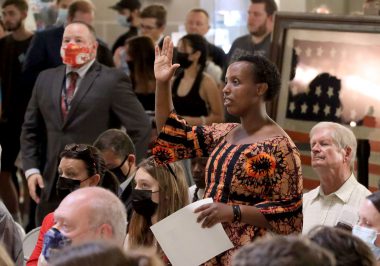On a hot day in August, hundreds of people gathered outside the State Capitol for a birthday party. The State of Missouri turned 200 years old on Aug. 10 and celebrated the occasion with festivities in Jefferson City. The highlight of Missouri Statehood Day for many was a formal ceremony held on the Statehouse lawn, but there were also exhibits, tours, musical performances, the swearing-in of 33 new U.S. citizens and an ice cream social, one of dozens held simultaneously in cities all across the state.

Not content with a single birthday observance, two days of activities commemorating the 200th anniversary of statehood were planned by the Missouri Bicentennial Commission, the panel of distinguished citizens chosen to spearhead the celebration. Intended as a statewide observance of Missouri’s history, the events held in the capital city were just part of a statewide celebration that saw activities planned in each of Missouri’s 114 counties.
Addressing the crowd gathered on the south lawn of the State Capitol on Tuesday, Gary Kremer, executive director of the State Historical Society of Missouri set the tone for the day. He recalled the divisive acceptance of Missouri into the union of United States – only possible through the adoption of the “Missouri Compromise” – and praised the perseverance and tenacity of early settlers. He recounted some of the more notable favorite sons and daughters of the state and spoke of the complexity and diversity of our people. At the end of his remarks, he held out a vision of even greater history to come. “Happy birthday, Missouri” Kremer said. “May you continue to be a place of promise, and may our third century of statehood be the time in which that promise is fulfilled.”

The ceremony on the Capitol lawn also included remarks by the governor, the chief judge of the Missouri Supreme Court and the unveiling of a new U.S. postage stamp bearing an image of the historic Bollinger Mill in southeast Missouri. Musical entertainment was provided by the Missouri National Guard’s 135th Army Band and the Missouri Choral Directors Association’s All-Star Festival Choir. Missouri’s poet laureate, Maryfrances Wagner, recited verses she penned in honor of the bicentennial.
Following the speeches and music, visitors and guests escaped the August heat and regathered in the cool comfort of the Capitol Rotunda to witness 33 applicants from 19 different countries take the oath of U.S. citizenship. Visitors to the Capitol also enjoyed a number of special exhibits commemorating the bicentennial. The Missouri State Quilters Guild presented the Missouri Bicentennial Quilt, with one panel representing each county in the state, as well as the city of St. Louis. The Missouri Bicentennial Mural was also on display. The brainchild of two southeast Missouri artists, the mural depicts iconic images from across the state and is a collaborate effort of nearly 15,000 Missourians who took brush in hand to each paint a small portion of the artwork as it traveled around the state in advance of the bicentennial celebration.

Throughout the day, the doors to the Missouri Senate chamber were open wide and visitors were invited to step onto the floor, a privilege typically reserved to senators and staff. Tours were also conducted across the street from the Capitol at the Missouri Supreme Court Building. Across town, Jefferson City’s landmark Central Dairy served ice cream cones as part of a statewide ice cream social. Similar events were held throughout the state in recognition of the invention of ice cream cones during the 1904 World’s Fair in St. Louis.
Residents of the Capital City took particular pride in one event. City and state leaders gathered on the north side of the Capitol to officially dedicate the Bicentennial Bridge. Once completed, the 830-foot-long pedestrian walkway and bike path will connect the Capitol grounds with a new park being developed along the Missouri River in Jefferson City. Funded by private donations, the bridge and park are the fulfillment of a half-century dream of local civic leaders. Completion of the project is expected later this year. In the meantime, Capitol visitors can admire a new Gold Star Memorial, positioned at the entrance to the bridge, which honors families of fallen American heroes.
